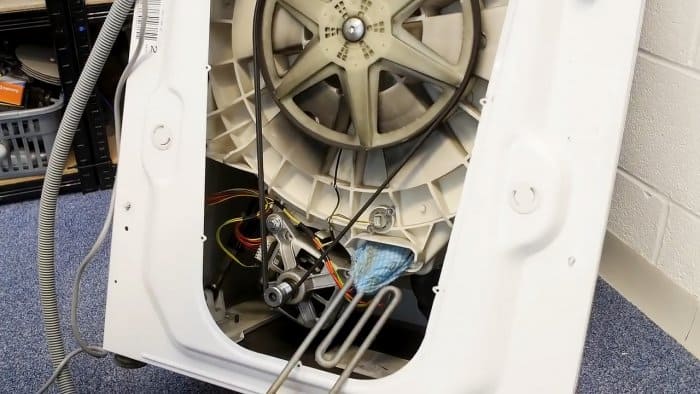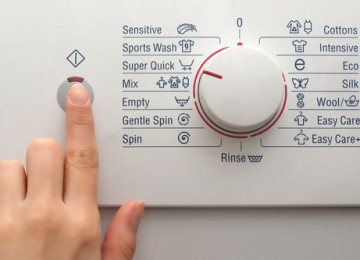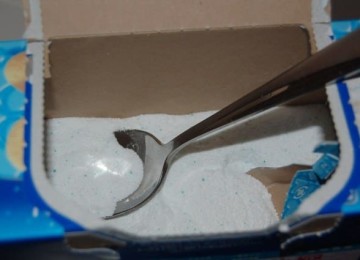 Clogged washing machine foreign objects is a fairly common situation. Any small objects can “go inside and not return” - be it an accidentally torn off button, a forgotten handkerchief, or anything else. Most often, it is socks that “go missing” in it - each of us at least once in our lives put a pair in the machine, but only took one out. Therefore, everyone should know how to get socks out of the washing machine on their own without damaging it.
Clogged washing machine foreign objects is a fairly common situation. Any small objects can “go inside and not return” - be it an accidentally torn off button, a forgotten handkerchief, or anything else. Most often, it is socks that “go missing” in it - each of us at least once in our lives put a pair in the machine, but only took one out. Therefore, everyone should know how to get socks out of the washing machine on their own without damaging it.
Consequences of clogging
Clogging household appliances with a foreign object does not bode well. Very often, such blockages cause obstruction of the drain pipe and lead to the fact that the apartment may be flooded. In addition, individual parts, such as a drum, may be damaged if the sock prevents it from functioning normally.
Even if you're not sure what you ran wash exactly 2 socks – it’s better to play it safe and make sure it doesn’t get stuck inside. Caution will help you maintain the integrity and performance of expensive equipment.
How to stop the machine
If you suspect that something has gone wrong, unplugging the cord is not the best solution.Such an action can cause a breakdown of the control module or the machine will remember the procedure being performed and return to it as soon as it is reconnected to the network.
To urgently stop the washing machine, you need to press the "Start / Pause" button, then press it again and hold it for about 5 seconds. After this, the process of stopping the machine will begin. If the pump fails to drain the water, then you need to do it yourself - through the "emergency" drain (it is a small hose located next to the filter) or through the filter itself. Draining the water is mandatory, because otherwise you will not be able to open the machine.
Where to look for a sock

Where socks go in a washing machine most often:
- Soft, sealing cuff on the hatch door;
- Bottom of the tank;
- Pipes;
- Drain filter or snail;
- Drum.
You can only find a stuck sock with your hands. Therefore, probing elements of the washing machine can take quite a long time.
Where to look first
As has already been said, it is better to start the search with the simplest. During this procedure, you can leave the automatic machine connected to the power supply: open the hatch door and look under the edge of the seal. The object could be stuck in the gap located there. If you notice a bulge or the edge of the sock, carefully remove it so as not to damage the seal.
If the cavity under the seal is empty, you need to check the drain filter.It is located in the front of the automatic machine, under the false panel or small hatch. Place a cloth under the drain, onto which the remaining liquid from the machine will drain, and unscrew it. Look for a sock in the filter opening and in the drain hose - socks often get caught there under the influence of strong water pressure.
Checking the bottom of the tank
If the simplest search methods do not bring the expected result, then you will have to disconnect the washing machine from the power supply and house communications, and begin more complex work. Move household appliances away from the wall so that you can inspect them without obstruction.
Check under heating element
The bottom of the tank is where socks often disappear from the washing machine. The first sign that this has happened is the appearance of a creaking sound during operation.
To find a product, you will have to make a lot of effort. It will be necessary to carry out dismantling One of the most important parts of the automatic machine is the heater. You need to be as careful as possible with the heating element, otherwise it may affect the further operation of the equipment.

Find out where the heating element is located on your equipment. Its location differs in different models: in some it is behind the back wall, and in others it is behind the front cover. Unscrew the housing wall bolts to gain access to the heater. In order to avoid problems in the future, be sure to photograph the location of the wires. Remove the element and inspect the resulting hole.
Shine a flashlight to get a good look at the bottom for any foreign objects. If you notice it, look for a wire or something else that can be used to hook and pull out the sock (a thin hook is ideal).
If you managed to pull out the stuck sock from the bottom of the tank, the machine should be assembled only after the surface of the rubber lining of the heater is cleaned of dirt. This will help you quickly return the heating element to its place. If suddenly this lining is damaged, it will have to be replaced.
Sock on the outer wall of the drum
If, in addition to the heater, it is necessary to find and remove the sock dismantle the drum, then it is better to seek help from a specialist. This is a rather complicated procedure, and it is difficult to understand it without special skills. In the worst case scenario, it may even be necessary to dismantle the drum elements or cut them.
If you still decide, unscrew the bolt that holds the drum pulley. Remove the pulley and screw the bolt back in. Knock the drum shaft out of the bearings. When the drum has moved off its axis, it should be rotated, trying to ensure that the stuck product is at the bottom. Remove the sock using long tweezers or stiff wire.
After the procedure, it is necessary to check the condition of the bearings. If they are covered with a thick coating, the oil seal should be replaced, as it has become unusable.









